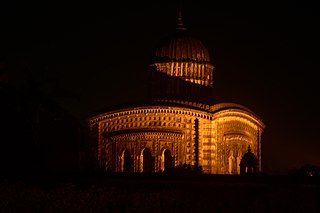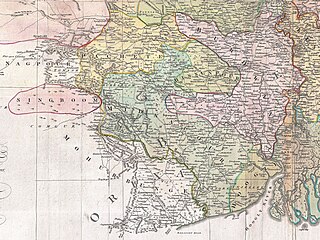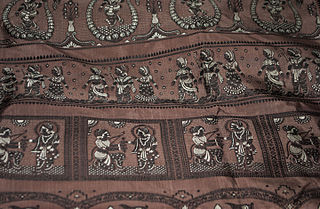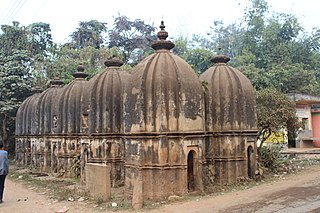
Bankura is a city and a municipality in the state of West Bengal, India. It is the headquarters of the Bankura district.Bankura was described as Suhmobhumi. The word larh or rarh was introduced after 6th century A.D. It comes from the old Austric word ráŕhá or ráŕho which means “land of red soil”. 2-n ancient times "China called Ráŕh by the name of 'Láti'". 3-n Santali, lar means thread, rarh means tune and larh means snake. 4-.Perhaps the Jain and Greek scholars used this original Austric word larh to indicate this dry forest region which was very difficult. The popularity of Manasa Puja, the worship of Snake-Goddess Manasa, shows this opinion might have some relevance. According to Nilkantha, a commentator of the Mahabharata, the words suhmo [bhumi] and Rarh are synonymous.

Bishnupur is a city and a municipality of Bankura district in the state of West Bengal, India. It is known for its terracotta temples built by the Malla rulers, historic Radha Krishna temples built during 1600–1800 CE and the Baluchari sarees.

Rarh region is a toponym for an area in the Indian subcontinent that lies between the Chota Nagpur Plateau on the West and the Ganges Delta on the East. Although the boundaries of the region have been defined differently according to various sources throughout history, it is mainly coextensive with the state of West Bengal, also comprising parts of the state of Jharkhand in India. Linguistically, the region is defined with population speaking the Rarhi Bengali local Bengali dialect.
Mukutmanipur is a village in Bankura district of West Bengal, India. It is located at the confluence of the Kangsabati and Kumari rivers close to the Jharkhand border.

History of Bankura district refers to the history of the present Bankura district in the Indian state of West Bengal.

Mallabhum was the kingdom ruled by the Malla kings of Bishnupur, primarily in the present Bankura district in Indian state of West Bengal.
Hambir Malla Dev was the forty-ninth king of Mallabhum. He ruled from 1565 to 1620 AD.
Chunaru is a Bengali Hindu caste whose traditional occupation is the manufacture of slaked lime from the shell of snails. After the advent of quick lime from limestone and the arrival of cement as mortar ingredient, the Chunaru struggled to make a living of their traditional vocation and gradually dwindled in numbers. According to Maniklal Sinha, there are only about two to three hundred Chunaru families in West Bengal today.

Baluchari Sari is a type of sari, a garment worn by women in Bangladesh and Indian states of West Bengal, Tripura and Assam. This particular type of sari originated in West Bengal and is known for depictions of mythological scenes on the anchal of the sari. It used to be produced in Murshidabad but presently Bishnupur and its surrounding areas of West Bengal are the only place where authentic Baluchari saris are produced. It takes approximately one week to produce one such sari. In 2011, the Baluchari Sari was granted the status of Geographical Indication for West Bengal in India.

Kalipada Singha Thakur was the last King of Malla dynasty of Bishnupur. He became King of Mallabhum in the year 1930 C.E.

Raghunath Malla Dev, also known as Raghunath Singha Dev, was the fifty-first king of the Mallabhum. He ruled from 1626 to 1656 CE.
Raghunath Singha Dev II was the fifty-fourth king of the Mallabhum. He ruled from 1702 to 1712.
Durjan Singha Dev was the fifty-third king of the Mallabhum. He ruled from 1682 to 1702.
Gopal Singha Dev was the fifty-fifth Raja of Mallabhum. He ruled from 1712 to 1748 CE.
Gopal Singha Dev II was the fifty-eighth king of the Mallabhum. He ruled from 1809 to 1876 CE.
Ramkrishna Singha Dev was the fifty-ninth king of the Mallabhum. He ruled from 1876 to 1885 CE.
Ranibandh is a village in the Ranibandh CD block in the Khatra subdivision of the Bankura district in the Indian state of West Bengal.
Ajodhya is a village in the Bishnupur CD block in the Bishnupur subdivision of the Bankura district in the state of West Bengal, India.

Joykrishnapur is a village in the Bishnupur CD block in the Bishnupur subdivision of the Bankura district in the state of West Bengal, India.
Maynapur is a village and a gram panchayat in the Joypur CD block in the Bishnupur subdivision of the Bankura district in the state of West Bengal, India.









